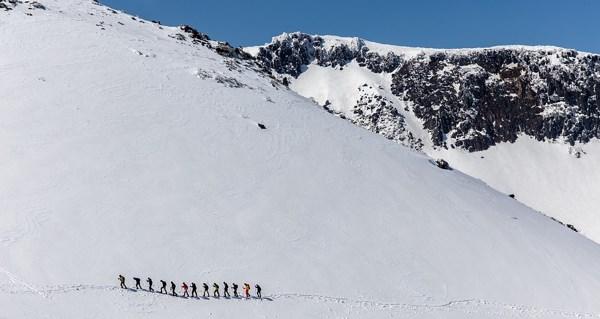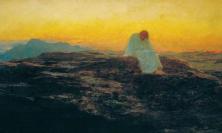‘The haunting celebration of the indescribable mystery of Jesus passing from death to new life, marks the completion of the journey of the Christian community through the wilderness of Lent to the promised land of Easter.’ Teresa White FCJ takes stock of our Lenten pilgrimage as we prepare for the joy and abundance that will characterise our arrival at Easter.
In early January, during a cold spell in France, where I was staying at the time, a météo bulletin on the television showed a line of eight or nine people mutely climbing up a steep, icy mountain path. There was a sheer drop on one side and the going was tough. Before long, the camera focused on a narrow side-track, and the climbers smiled when they saw it. It led to an almost invisible aperture, like a portal, framed by bare, snow-laden branches of stunted trees on either side. The climbers passed through, and there below them was a steaming pool. They all ran towards it, stripped off their outer clothing and entered the water with shouts of joy. I think the journalist said the surrounding temperature was -10 or -12 degrees Celsius...
Remembering that scene, the arduous, silent journey and the ecstatic arrival, it seemed to me to be an image of Lent. For this liturgical season, moving towards its culmination in the celebration of Easter, encapsulates two symbols that are deeply rooted in the human imagination: wilderness and paradise, desert and Promised Land. The Easter Vigil, the haunting celebration of the indescribable mystery of Jesus passing from death to new life, marks the completion of the journey of the Christian community through the wilderness of Lent to the promised land of Easter.
Any wilderness, cold or hot, is filled with contradictions. At once frightening and fascinating, it offers the worst and the best of human experiences. It may be a place of sand and scorching sun, where there is sparse foliage and little water; or it may be a bare, cold landscape, a precipitous mountain, rendered all but inaccessible by ‘winter and rough weather’. The journey through it is demanding, and there are no signposts; the travellers are in danger of straying. Wandering from the ‘right’ path can lead to a keen sense of abandonment, to despair: will they ever reach their destination? Those who walk in this place of challenge may be faced not only with bewilderment, but with long, dark nights, with hunger and thirst, with loneliness and silence.
Yet the wilderness is also a sacred place where the presence of the ‘other world’ is discernible to those with eyes to see and ears to hear. In the Christian tradition, those who go into the wilderness pray that all their senses will be made alert to that which is elusive elsewhere. It is an archetypal place of encounter with the divine, for in the solitude of the wilderness there is also revelation. God’s presence can be very real in this place of apparent sterility and strange, unlooked-for beauty, as Carlo Carretto discovered during his extended retreat in the Sahara. To his own amazement, he did not find it a hostile environment. He rejoiced in his time there, undeterred even by the cold desert nights: ‘I shall never forget the nights under the Saharan stars’, he wrote. ‘I felt as if I were wrapped around by the blanket of the friendly night... The darkness is necessary, the darkness of faith is necessary, for God’s light is too great. It wounds.’ (Letters from the Desert, pp. 139, 141)
This ‘other world’ – Arcadia, Eden, Utopia, Paradise, Nirvana, the Promised Land … whatever name we give it – we are always seeking it. It is as if we have lost something that belongs to us by right and we cannot rest until we find it. Is it home we are looking for? Is it an abiding peacefulness? Is it the touch of God? Whatever it is, it eludes us. We glimpse it sometimes, but never quite manage to catch hold of it, possess it, never really make it our own. Yet when we take time to pray, to reflect, to move away from the jumble of existence and spend time in the wilderness, things which had previously escaped us become more clearly visible. And our ears, momentarily unblocked, hear echoes of melodies that are new yet strangely familiar. Lent, that season of prayer and fasting, can unlock the doors of the enclosures in which we so often find ourselves and set us free to walk courageously into the unknown. So we embark on a journey through the wilderness, a testing journey of waiting, silence and awakening.
When Moses led the Israelites out of Egypt, he took them through the desert where they spent the proverbial 40 years. There, where there were no distractions, where mere survival was all-important, God could mould them to be his people. Speaking to Israel, he says, in the words of Hosea to his unfaithful wife: ‘I will now persuade her, and bring her into the wilderness, and speak tenderly to her… And I will take you for my wife forever; I will take you for my wife in righteousness and in justice, in steadfast love, and in mercy.’ (Hosea 2:14, 19). These words movingly express the traditional Judaeo-Christian conviction that the desert is a place of formation, where God speaks to the hearts of his people, saves them and makes them his own. A beautiful poem that is included in the prophecy of Isaiah sees God doing this for the Israelites during the Babylonian exile, and as a result the wilderness and the dry-lands exult, the wasteland rejoices and blooms, the streams and rivers gush out in the desert, the scorched earth becomes a lake, the parched land springs of water (Isaiah 35:1ff). The wilderness is a place of change, of conversion, of transformation.
Some people dread Lent, as I sometimes do myself, anticipating that it will be long and gloomy; we cannot wait for Easter. Yet could there be an Easter without a Lent? Naturally enough, wildernesses, deserts, could be and often are considered negative environments, with their enforced austerity, their lack of human comforts and normal social amenities. Yet in Lent, when we respond to the Church’s call to enter these places, to walk, with Jesus Christ, the Way of the Cross, we can find within ourselves what Keats called a certain ‘negative capability’. He defined this as the ability to be, ‘in uncertainties, mysteries, doubts, without any irritable searching after fact and reason’. He was not writing here from a specifically religious perspective, but what he says is wonderfully apposite to the experience of anyone undertaking the journey of faith during the season of Lent.
The wilderness is not an end in itself. It is closely related to journeying, to pilgrimage. Most of us do not enter the desert to stay there for good, do not desire to make our homes in a bleak, trackless wilderness. We pass through, on our way to a more fertile, welcoming terrain, for we believe with Pope Francis that, ‘God does not hide himself from those who seek him with a sincere heart, even though they do so tentatively, in a vague or haphazard manner’ (Evangelii Gaudium §71). On the journey, with sharpened senses, we may see fragile flowers blooming in the crevices of rocks, drops of morning dew clinging to meagre grass-blades; we may find ourselves listening to the whispering wind, to the music that arises from the silence of creation. We may experience some of these glimpses and touches of God on the Lenten pilgrimage, and we trust that he will lead us on the sacred way through the wilderness to the joy and inner peace of Easter.
Sister Teresa White belongs to the Faithful Companions of Jesus. A former teacher, she spent many years in the ministry of spirituality at Katherine House, a retreat and conference centre run by her congregation in Salford.






